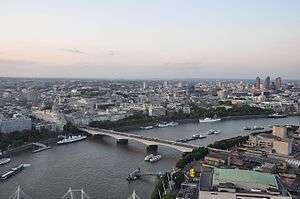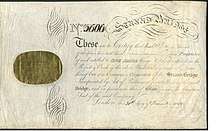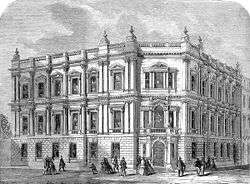Waterloo Bridge
Waterloo Bridge (/ˌwɔːtəˈluː/[1][2]) is a road and foot traffic bridge crossing the River Thames in London, between Blackfriars Bridge and Hungerford Bridge. Its name commemorates the victory of the British, Dutch and Prussians at the Battle of Waterloo in 1815. Thanks to its location at a strategic bend in the river, the views from the bridge (of Westminster, the South Bank and the London Eye to the west, and of the City of London and Canary Wharf to the east) are widely held to be the finest from any spot in London at ground level.
Waterloo Bridge | |
|---|---|
 | |
| Coordinates | 51°30′31″N 0°07′01″W |
| Carries | A301 road |
| Crosses | River Thames |
| Locale | London |
| Named for | Battle of Waterloo |
| Heritage status | Grade II* listed structure |
| Preceded by | Hungerford Bridge and Golden Jubilee Bridges |
| Followed by | Blackfriars Bridge |
| Characteristics | |
| Design | Box girder bridge |
| Total length | 1,230 feet (370 m) |
| Width | 80 feet (24 m) |
| Longest span | 233 feet (71 m) |
| History | |
| Opened | (first bridge) 18 June 1817 (second bridge) 11 March 1942 |

| |
History
First bridge




The first bridge on the site was designed in 1807–10 by John Rennie for the Strand Bridge of Life and opened in 1817 as a toll bridge. The granite bridge[3] had nine arches, each of 120 feet (36.6 m) span, separated by double Doric stone columns, and was 2,456 feet (748.6 m) long, including approaches–1,240 feet (378.0 m) between abutments–and 42 feet (12.8 m) wide between the parapets. Before its opening it was known as the Strand Bridge.
During the 1840s the bridge gained a reputation as a popular place for suicide attempts. In 1841 the American daredevil Samuel Gilbert Scott was killed while performing an act in which he hung by a rope from a scaffold on the bridge.[4] In 1844 Thomas Hood wrote the poem "The Bridge of Sighs", which concerns the suicide of a prostitute there.[5]
Paintings of the bridge were created by the French Impressionist Claude Monet and the English Romantic John Constable.
The bridge was nationalised in 1878 and placed under the control of the Metropolitan Board of Works, which removed the toll from it.
Michael Faraday tried in 1832 to measure the potential difference[6] between each side of the bridge caused by the ebbing salt water flowing through the Earth's magnetic field.[7] See magnetohydrodynamics.
From 1884 serious problems were found in Rennie's bridge piers, after scour from the increased river flow after Old London Bridge was demolished damaged their foundations. By the 1920s the problems had increased, and settlement at pier five necessitated the closure of the whole bridge while some heavy superstructure was removed and temporary reinforcements were put in place.[8]
In 1925, a temporary steel framework was built on top of the existing bridge and then placed next to it for the use of southbound vehicles (the postcard image shows this, and the settlement especially to the left of the fifth pier).[9]
Second bridge

In the 1930s London County Council decided to demolish the bridge and replace it with a new structure designed by Sir Giles Gilbert Scott. The engineers were Ernest Buckton and John Cuerel of Rendel Palmer & Tritton. The project was placed on hold due to the Second World War.
Scott, by his own admission, was no engineer and his design, with reinforced concrete beams (illustrated) under the footways, leaving the road to be supported by transverse slabs, was difficult to implement. The pairs of spans on each side of the river were supported by beams continuous over their piers, and these were cantilevered out at their ends to support the centre span and the short approach slabs at the banks. The beams were shaped "to look as much like arches as ... beams can".[8] They are clad in Portland stone, which is cleaned by rain.[10] To guard against the possibility of further subsidence from scour each pier was given a number of jacks that can be used to level the structure.[8]
The new bridge was partially opened on Tuesday 11 March 1942 and "officially opened" in September 1942.[11] However, it was not fully completed until 1945.[12] It is the only Thames bridge to have been damaged by German bombers during the Second World War.
The building contractor was Peter Lind & Company Limited. It is frequently asserted that the work force was largely female and it is sometimes referred to as "the Ladies' Bridge".[13][14] Lind used elm from the old bridge for the dining room floor of Hamstone House, his house that he commissioned and built in 1938 in St George's Hill in Surrey.[15]
Georgi Markov, a Bulgarian dissident, was assassinated on Waterloo Bridge on 7 September 1978 by agents of the Bulgarian secret police, the Committee for State Security, possibly assisted by the Soviet security agency, the KGB.[16]
Reuse of the original stones
Granite stones from the original bridge were subsequently "presented to various parts of the British world to further historic links in the British Commonwealth of Nations". Two of these stones are in Canberra, the capital city of Australia, sited between the parallel spans of the Commonwealth Avenue Bridge, one of two major crossings of Lake Burley Griffin in the heart of the city. Stones from the bridge were also used to build a monument in Wellington, New Zealand, to Paddy the Wanderer, a dog that roamed the wharves from 1928 to 1939 and was befriended by seamen, watersiders, Harbour Board workers and taxi drivers. The monument, built in 1945, is on Queens Wharf, opposite the Museum of Wellington City & Sea. It includes a bronze likeness of Paddy, a drinking fountain and drinking bowls below for dogs.[17][18]
Another piece of the stone is situated under the sundial in the Wellington Boat Harbour Park, next to Clyde Quay Marina, an area of historical significance in Wellington Harbour. Several stone balusters from the demolished bridge were sent in the late 1930s by the authour Dornford Yates to be used in his French home 'Cockade', but the Fall of France in 1940 interrupted this project. They were shipped after the war to his new house in Umtali, Rhodesia (now Mutare, Zimbabwe).
Geography
The south end of the bridge is in the area known as the South Bank, which includes the Royal Festival Hall, Waterloo station, Queen Elizabeth Hall and the Royal National Theatre, as well as the BFI Southbank, which is directly beneath the bridge.
The north end of the bridge passes above the Victoria Embankment where the road joins the Strand and Aldwych alongside Somerset House. This end housed the southern portal of the Kingsway Tramway Subway until the late 1950s.
The entire bridge was given Grade II* listed structure protection in 1981.[19]
The nearest London Underground station is Waterloo, the nearest National Rail station is London Waterloo.
In popular culture
- Robert E. Sherwood's play Waterloo Bridge (1930), the story of a soldier who falls in love and marries a woman he meets on the bridge in an air raid during the First World War, was made into films released in 1931, 1940 and 1956. The second of these film versions starred Vivien Leigh and Robert Taylor.
- "After the Lunch", a poem by Wendy Cope about two lovers parting on Waterloo Bridge, now forms the lyric of the song "Waterloo Bridge" by Jools Holland and Louise Marshall.
- The bridge features in the film “A Window in London” (1940). The hero, played by Michael Redgrave, is a crane driver who is working on the construction of the bridge. Images can be seen of the incomplete rebuilding work in progress.
- The bridge features in scenes at the beginning and end of the film Alfie (1966), starring Michael Caine. In the final scene of the film the title character is seen crossing the bridge followed by a stray dog.[20]
- The song "Waterloo Sunset" by the British band The Kinks tells of living in London and watching life from Waterloo Bridge.
- A scene in "The Great Game", an episode of the BBC television series Sherlock, takes place beneath the bridge's northern side, where members of Sherlock's network of homeless informants congregate.[21]
- The bridge features in the closing scene of the 1996 film Trainspotting.[22]
- The bridge is the original mural location of the Banksy 2004 graffiti artwork Balloon Girl, created on the South Bank in 2004.
- According to the composer himself, during the final episode of Everybody's Kitchen, this is the place that inspired "Kiss The Rain", a piano piece by Korean pianist Yiruma, as it was on his way to King's College London while he studied university.
- The bridge is mentioned in the book Cloud Atlas by the character Robert Frobisher.
References
- "Definition of 'Waterloo'". www.collinsdictionary.com. Retrieved 29 May 2020.
- "Definition of Waterloo noun from the Oxford Advanced Learner's Dictionary". www.oxfordlearnersdictionaries.com. Retrieved 29 May 2020.
- The granite came from quarries at Mabe in Cornwall; Mee, Arthur (1937) Cornwall. London: Hodder & Stoughton, p. 132
- Jay, Ricky (1987) Learned Pigs and Fireproof Women: Unique, Eccentric and Amazing Entertainers: Stone Eaters, Mind Readers, Poison Resisters, Daredevils, Singing Mice, etc., etc, etc., etc.. New York: Villard Books, p. 150. ISBN 0-394-53750-5
- Brewer, Ebenezer (1970) Brewer's Dictionary of Phrase and Fable. London: Cassell, p. 152.
- David P. Stern (18 November 2000). "Teaching about the Earth's Magnetism in Earth Sciences-Part 3". Phy6.org. Baltimore Meeting of the Natl. Science Teacher Assoc. Retrieved 15 July 2017.
- Faraday, Michael Experimental Researches in Electricity, Vol. 1, London, 1839, p. 55.
- Hopkins, Henry (1970). A Span of Bridges. Newton Abbot, England: David and Charles. pp. 257–260.
- Historic England. "Waterloo Bridge (1275000)". National Heritage List for England. Retrieved 25 February 2017.
- Sutcliffe, Anthony (2006). London: An Architectural History. New Haven, CT: Yale University Press. p. 212.
- Life in the War:BBC documentary
- Eade, John. "Waterloo Bridge - WHERE THAMES SMOOTH WATERS GLIDE". thames.me.uk. Retrieved 7 April 2018.
- Staff writer. "The Ladies Bridge". Peter Lind & Company Limited. Archived from the original on 21 November 2008. Retrieved 7 May 2009.
- Karen Livesey. "The Ladies Bridge". theladiesbridge.co.uk. Archived from the original on 2 April 2015. Retrieved 24 March 2015.
- Malcolm Airs (2002). The Twentieth Century Great House. Department for Continuing Education, Oxford University. p. 72. ISBN 978-0-903736-31-2.
- "Cold War Assassination: The Umbrella Murder of Georgi Markov". www.murdermap.co.uk. Retrieved 7 April 2018.
- Haworth, Dianne (2007). Paddy the Wanderer. Auckland, New Zealand: Harper Collins. pp. 158–159.
- Moor, Christopher (30 July 2009). "Remembering Paddy the Wanderer: Tales of a Unique Dog". The Wellingtonian. Retrieved 13 June 2013.
- Historic England. "Details from listed building database (1081053)". National Heritage List for England. Retrieved 27 November 2008.
- Neil Mitchell (11 May 2012). World Film Locations: London. Intellect. ISBN 184150484X.
- "Locations: Waterloo Bridge". Sherlockology: The Ultimate Guide for Any BBC Sherlock Fan. sherlockology.com.
- "Surprisingly beautiful places that appear in Trainspotting". The Daily Telegraph. London. 27 January 2017. Retrieved 7 April 2018.



